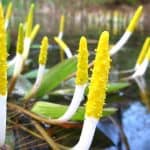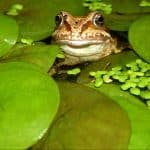Last updated on March 9th, 2022
Our site is reader supported, this means we may earn a small commission from Amazon and other affiliates when you buy through links on our site.
If you have a small garden or perhaps your garden is on a slope that is otherwise dangerous for growing, or you might just have finicky soil whose composition you don’t want to work hard to amend every year, you can always opt for growing perennials in pots. Growing plants in pots is a much easier way to control things like pests, it’s especially easier to access optimum sunlight if you have a garden that gets filtered sun throughout the day in various spots so you can move the pots when necessary.
That being said, there are so many stunning plants available from which to choose from that are ideal for pot growing, and below you will find our ten favourite perennial plants. These hardy perennials for pots are strong enough and giving them the right amount of space is really all you need to do, along with some general maintenance.
Of course, the best perennials for pots are going to be those whose structure, blooming cycle, flowers, and maintenance levels are what you like best. So pay attention to these different perennials for containers and figure out which one you might want to try. We start our list with Lavender, this grows very well in pots and has multiple uses including cooking.
1. Lavender ‘Munstead’
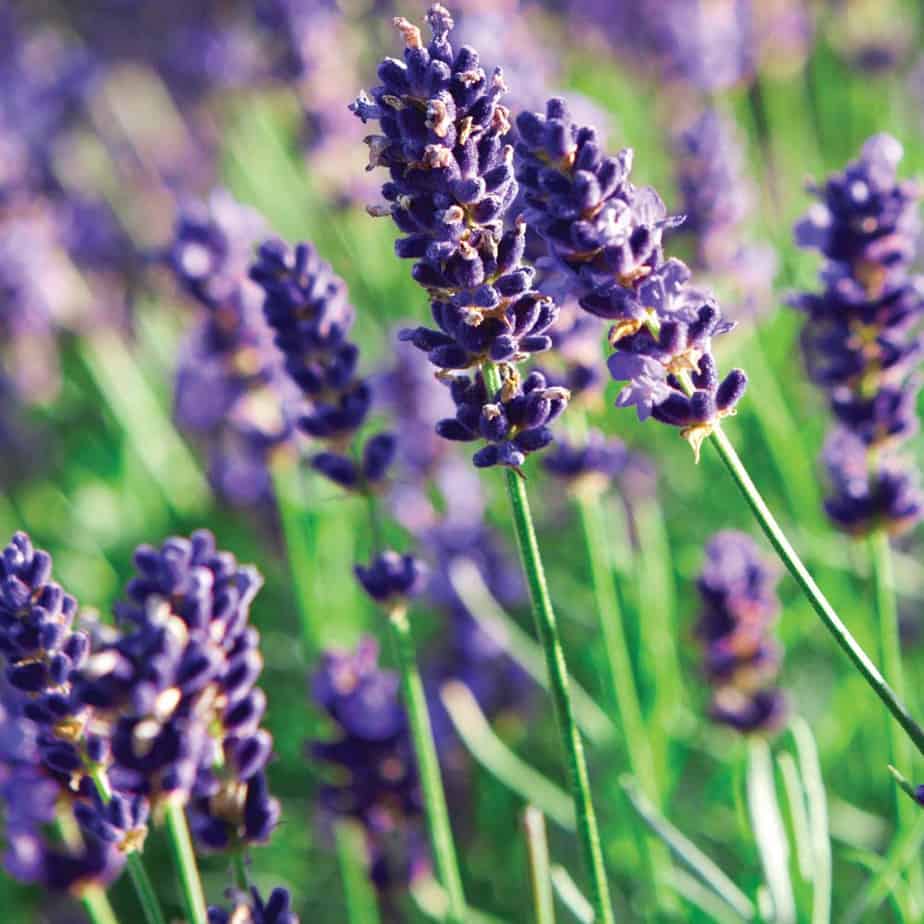
Lavender is probably one of the most popular herbs, and it makes an excellent choice for growing in pots. It prefers full sun and will tolerate a range of conditions as long as you water them accordingly. It is a rugged and compact evergreen plant that is more like a shrub than a perennial, that grows in a mound shape with green-grey foliage and produces rich Lavender flower spikes. This particular variety is what you will commonly find in oils or dried sprigs placed in rooms.
It is a compact plant that grows slower than other shrubs so you can rest assured that as you watch it develop you won’t have to do a great deal of pruning to maintain its size or shape, although some pruning is recommended. On average it reaches about 30cm in height and spread. Growing it in pots, you won’t need to invest in particularly large containers for it to thrive. Best of all, you can move the pots around your garden to enjoy not just the floral display but the aromatic fragrance that Lavender has to offer. One of our favourite plants for growing in pots.
2. Erysimum ‘Bowles’s Mauve’
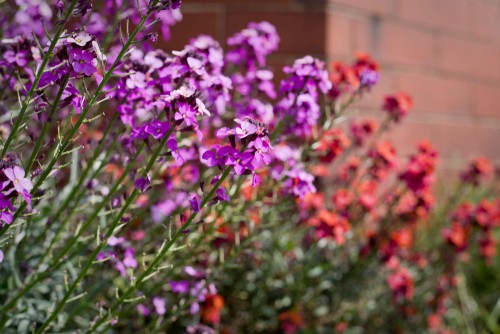
The Erysimum brings with it a rich display of blooms from the middle of spring all the way through until autumn. It offers four-petalled flowers all held together in a dense raceme. It is an award-winning plant, not just for the floral display, but for the attractive grey-green foliage it provides throughout the winter, it will even continue to flower through the winter in many areas too. The Royal Horticultural Society has awarded this plant the Award of Garden Merit.
It is incredibly versatile and can be mixed in containers with other perennials or flowering bulbs. You can even grow it in an isolated fashion if you so choose. Wherever you place the pots be sure to find the sunniest of locations. This plant prefers moderate soil that is well-drained and will bring to your garden butterflies and bees. At its full maturity, it reaches a span between 60cm and 75cm in height and between 45cm and 60cm in spread. The branches form freely in a very erect, bushy fashion.
3. Hosta
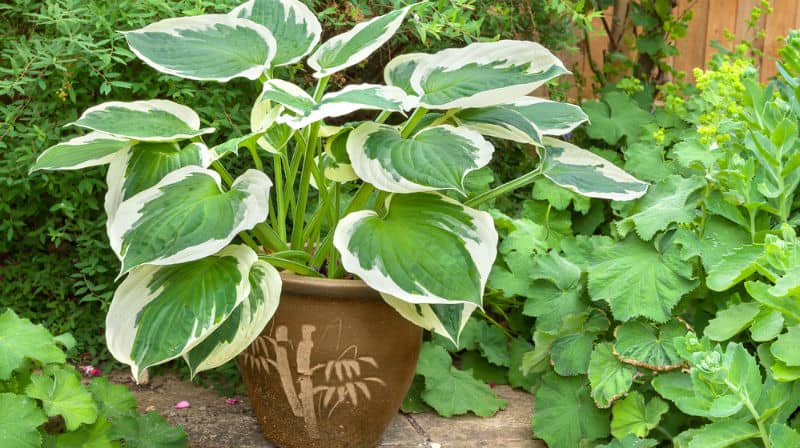
These strong perennials are perfect for any garden but especially for patios that have to contend with a great deal of shade. Hostas are very reliable plants, simple to grow, and they live a long time. The best part is there are so many textures and sizes out there that work in containers of any kind. When you grow Hostas you will find that the attractive foliage is what makes them stand out. They certainly produce lovely flowers in the summer, taking on shades of pink, lavender and even pure white. The flowers are so beautiful that bees simply can’t stay away. But without a doubt what makes them most famous is the design of the leaves that offers a bright green centre and a somewhat yellow-tinged perimeter.
4. Heuchera – Coral Bells
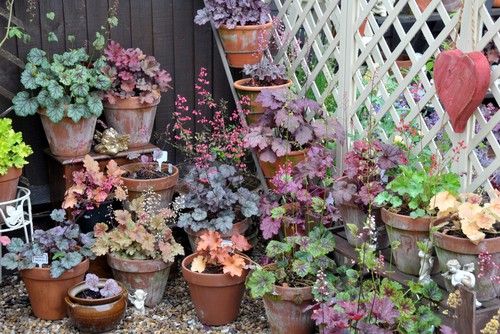
Coral Bells produce a wonderful traditional form of foliage that offers a variety of textures for any garden. Originally grown for the stunning flowers that bring to your garden butterflies and are used heavily in floral arrangements, they have recently made a resurgence thanks to the beautiful leaves they produce.
You can add colours in just about every shade, ranging from copper to purple, green, yellow and even peach. So if you want to add different colours to your garden, you can mix and match various Coral Bells in your pots and containers around other stunning perennials. Coral Bells thrive best with full sun or partial shade and will do well in potting soil so you won’t have to worry about making amendments to things like the pH levels in your garden.
5. Penstemon
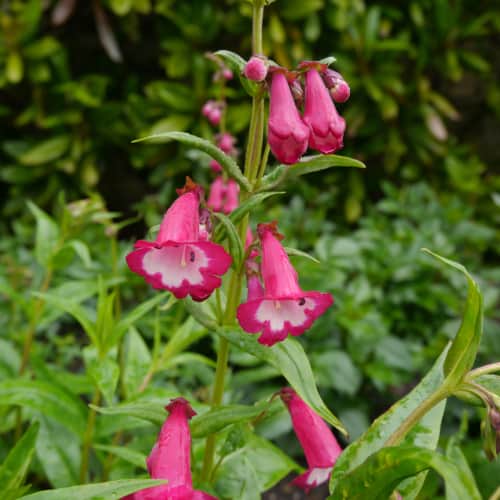
Produces colourful, tubular flowers that grow on tall spikes and are commonly found in prairies that are exposed to sunny conditions. Such a beautiful wildflower (also referred to as Beardtongue) that can be easily grown in your garden, especially if you grow them in containers but they need plenty of water but they don’t like to be too wet. They don’t like to be crowded so it’s important to grow them individually rather than try to group them with other flowers because they will start to wilt when grown together in pots.
They are very easy to care for, in full bloom they make wonderful additions as cut flowers in your home. They are quite tolerant of dry soil once established and they thrive when kept in moist soil. These plants form dense spikes of flowers starting at the beginning of summer. The plant will grow no larger than one metre in height depending on the variety. There are plenty of smaller varieties that grow upwards of 30cm and are perfect for smaller containers. You can pick from many flowers including white, red, pink, purple and blue.
6. Campanula – Bellflower
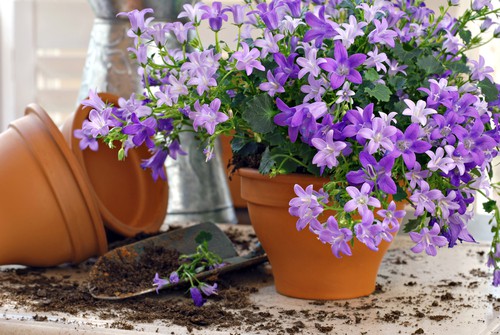
Bellflowers are great for containers, especially if you live in an area that has (on average) cool summer temperatures. The nice part about Bellflowers is that you can find herbaceous, annual, or perennial versions. At the end of spring and summer, they start to steal the show with their bell-shaped flowers which is what lends itself to the special name they have. The flowers can come in different shades of pink, white, purple or blue. With Campanulas, there are hundreds of species that range in size, so you can opt for low-growing varieties that are much smaller and perfect for containers.
Popular versions include the ‘Pink Octopus’ that produces lantern-shaped buds that open into soft pink, octopus-like flowers that have thin, long spidery petals. The ‘Sarastro’ forms clumps as a perennial and offers spires of big, bell-shaped flowers that droop downwards in rich violet and purple shades. ‘Samantha’ is the variety that offers compact, mat-forming structures with flowers that open into a traditional five-petal design the inside of which is white and the perimeter is light purple.
7. Dianthus – Garden Pinks
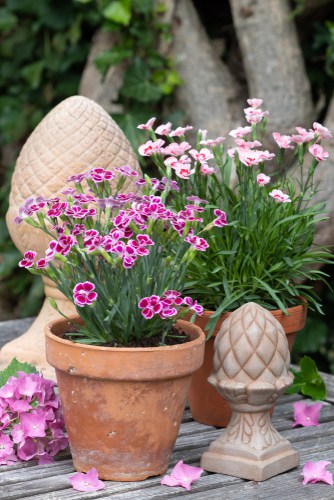
These ‘Pinks’ prefer fluffy soil that is full of compost, lightened clay or sand which is well-drained. They will grow just about anywhere as long as you reward them with as much sun as possible. While they need at least 6 hours, the more sun you provide, the more flowers you will enjoy.
There are hundreds of varieties from which to choose, each of these takes on slightly different characteristics but of course, all of which bring to your garden pink displays of some degree or another, and you find other colours such as white. You can select varieties that produce flowers where the petals contain a block of rich pink surrounded by rich red made all the more impressive because the perimeter doesn’t bleed into the centre (as often happens with multi-toned flowers) but instead is very distinct and geometric. Other options include light pink, light pink with a tinge of red or other colours. They are perfectly suited to pots too.
8. Hemerocallis – Day Lily
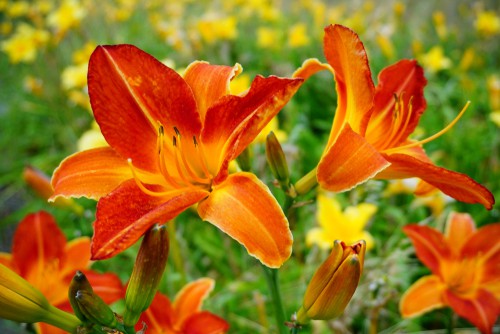
These Day Lillies are very tolerant of drought and once established they are also tolerant of rabbits, so if you have some small furry friends who like to munch on your flowers, rest assured they should leave your Day Lily alone. They will typically bloom for a short amount of time between one week and five weeks and this is mostly determined by the weather. As they bloom you can enjoy a variety of shades, all of which take on the same five-leaf design. The interiors are close to the same and typically have a brighter yellow centre while varieties range in terms of the exterior petal colour. Of course, you can find varieties that have the same monochromatic design all the way around.
Hemerocallis are happy in all manner of soil types and pH levels, including acidic soil, alkaline soil, neutral soil, chalk soil, clay soil or loam so they grow very well in containers because you don’t need to alter the soil to combine these Day Lillies with other plants that have longer flowering periods or with evergreens so that you can enjoy colour in your container all year round. At full maturity, they will span between 60cm and 90cm in spread so plan accordingly. You also may need to stake the flower stems too when they are in flower and grown in pots.
9. Brunnera – False Forget-me-not
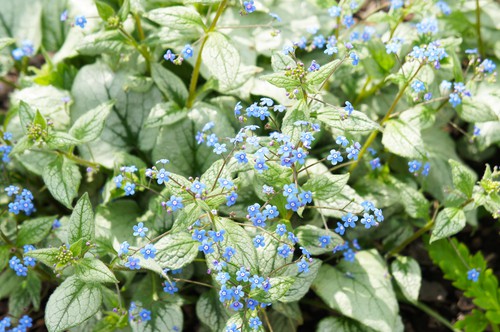
Also known as the False Forget-me-not, the Brunnera is a low mound-forming plant that at full maturity stays no taller than 25cm. Most of its height actually comes from the large flower stalks this perennial has to offer. While it thrives best in partial shade or full shade, you can theoretically grow it in full sun, however, it requires an excess of water in full sunlight and in most cases will go into dormancy because of extreme heat so it is best to move your container somewhere the plant will receive partial shade at least. Starting in the middle of spring you will get about one month of flowers, delicate sprays of blue flowers that stand above the foliage. The shades range from a rich electric blue all the way to pastel blue.
10. Geum ‘Mrs Bradshaw’
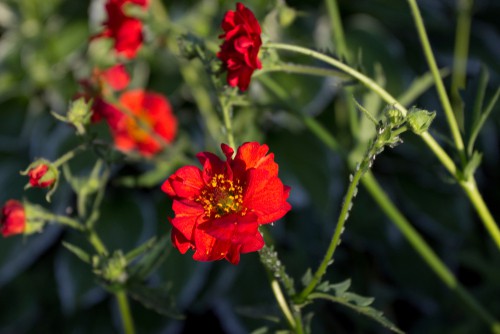
This plant grows in well-drained soil with full sun, although it is happy in partial shade. It brings stunning red flowers that are very showy which you can deadhead in order to get a second round of flowers if you see fit, or you can leave them as the spent blooms and they will produce fluffy seed heads that you might enjoy. The orange-scarlet flowers grow in loose panicles and they rise above the foliage which actually adds to the overall height of the plant, which is otherwise quite short. It forms foliage mounds that take on a heart shape for each of the leaves.
Now you have a long list of potential perennials for containers that you can add to your garden. Whether you simply want to add containers to the perimeter of an existing garden, use them as accent pieces, or place them on your patio, you now have ample options.

